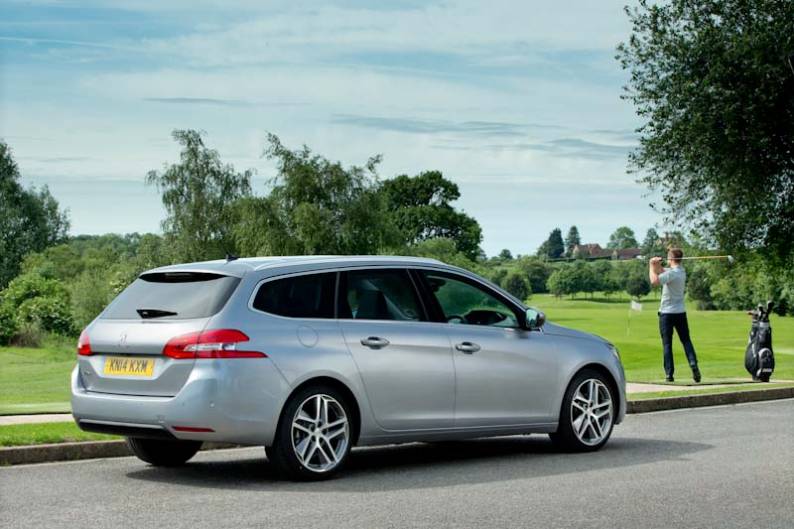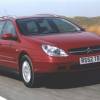
RAC sale – up to 33% off*
• Roadside cover from £5.29 a month†
• We get to most breakdowns in 60 mins or less
• Our patrols fix 4/5 breakdowns on the spot

By Jonathan Crouch
Introduction
The second generation 'T9'-series Peugeot 308 SW estate is a rarity; a compact estate car that not only looks good but is really practical too. Unlike previous cars in this model line, there's no seven seat option but otherwise, unless you come in search of cutting-edge dynamics, this model's hard to fault thanks to a classy interior, a comfortable ride, some excellent efficiency numbers and, most importantly of all, enough space in the boot to embarrass every other rival in the segment.
Models
5dr SW estate (1.2 petrol / 1.5, 1.6, 2.0 BlueHDi diesel) [Active, Allure, GT-Line, GT, GTi]
History
We've always struggled a little with the concept of a 'small estate car'. After all, most people buy an estate in search of space and versatility, both tough briefs to meet if the model in question is in any way compact. Though not in this case. Not with this car - Peugeot's second generation 'T9'-series 308 SW.
Here's proof positive that it isn't how big your car is that matters. It's how cleverly it's been designed for interior use of the space that it has. This 308 SW measures in at just under 4.6m but offers up to 1660-litres of space. The brand's larger 508 SW from this period, in contrast, measuring in at around 4.8m, has 1598-litres inside. You can see the point.
Nor is this 308 SW merely able to embarrass its larger stablemate. Its carriage capacity routinely over-shadows that of many other apparently much larger estate models. All of which is at least some compensation for the fact that, rather surprisingly in view of the size advantages we've just been talking about, this car lacks the unique selling point that characterised both of its direct predecessors. Namely, the optional provision of a third seating row for potential seven-seat capacity.
The lack of that feature certainly reduced the necessity for the designers to make this car so boxy when it came to styling this second generation 'T9' model. Most estate buyers these days seem to be looking for swoopier, more stylish shapes, a demand this Peugeot was better set to meet. It promises to satisfy on other levels too, primarily in offering one of the segment's most efficient range of engines, including a potent 180hpp 2.0-litre BlueHDi diesel unit for the top GT variant.
The range was facelifted in 2017, at which point the initial entry-level diesel, a 1.6-litre BlueHDi unit, was replaced by a more efficient 130hp 1.5-litre BlueHDi engine. A further mild facelift was added in July 2020, which included the installation of Peugeot's more advanced digital i-Cockpit interior layout. The replacement third generation 308 SW model was launched in mid-2021.
What You Get
An estate car ought to be properly bigger than the family hatchback it will usually have been derived from. The fact that so few of the smaller ones are is down to laziness and cost-cutting that usually sees estate versions of Focus-sized models sharing exactly the same wheelbase and underpinnings as their hatchback counterparts. When it came to this MK2 model 308 SW though, Peugeot did the job properly thanks to a light, rigid EMP2 platform that enabled them to give this car a wheelbase 110mm longer than that of the ordinary hatch.
Lift the (rather heavy) plastic tailgate and the wide aperture reveals the largest loading bay in the class, the 660-litre cargo bay 30-40% bigger than that offered by some direct competitors. Smaller items meanwhile, can be secured by an elastic strap on the left hand side trim and just above that, you'll find one of the levers for the clever 'Magic Flat' seat-folding system. The 'Magic' bit refers to the way that rear seatbacks don't just flop on the seat bases as would be the case with some rivals: that would create an upward incline in the flattened cargo area floor. To avoid that in this 308 SW, the seat bases move forward and down slightly as you pull that 'Magic Flat' lever. And sure enough, as a result, you do get a remarkably flat total loading bay with a class-leading 1,660-litres of space - or theoretically up to 1,775-litres if you load right up to the roof.
We mentioned earlier that Peugeot had extended the wheelbase of the basic 308 design to create this car and one of the other advantages of that is that the slightly cramped standards of rear seat passenger room that you get in the hatchback version are in this case much improved. The longer wheelbase means that the rear doors can open wider and the seats inside are positioned a little further back, so it'll be slightly easier for parents to install booster cushions and the like.
Once you do take a seat at the back, the 29mm of extra legroom on offer is certainly welcome, but it still doesn't make this car the most spacious contender in this segment. As usual in a car of this class, there's reasonable space for two adults but three will be cramped unless they're of school age. Get a car originally specified with the full-length 1.6m2 panoramic glass roof and there's the bonus of an airy-feeling atmosphere but the downside is the way the arrangement robs taller passengers of those last few millimetres of headroom.
Take a place in one of the very comfortable seats up front in what Peugeot rather pretentiously calls the 'i-Cockpit' and four things are immediately apparent: quality, lack of button clutter, the big centre-dash LCD infotainment screen and, most notably, the tiny steering wheel above which (rather than through which) you're supposed to view the instruments with their finely sculpted red needles. Let's start with that, part of an arrangement first seen on the smaller 208 supermini but more effectively delivered here because it's easier to see the high-mounted dial pack above the wheel rim. Yes, it's a bit of a culture shock. Yes, you'll eventually get to like it. Yes, you should ignore whinging journalists who don't.
With that issue out of the way, you can start to look around the cabin and try and appreciate what Peugeot has tried to do with the interior of this 308. With the possible exception of the rather incongruous-looking over-sized gear knob, it's all very nice indeed, with lovely touches like the Aston Martin-style contra-rotating rev counter. Plenty of soft-touch plastics and cool chrome finishes mean that the quality's certainly a cut above what you'd expect from a model priced against rivals from Ford, Vauxhall, Toyota and Renault. But perhaps we shouldn't be surprised by that. After all, Peugeot owns the company - Faurecia - that produces many of the premium quality interior furnishings you get in posh German cars.
Jump into this model after familiarisation with, say an Astra or Focus Estate rival and you'll wonder where all the buttons have gone. There's a small central cluster of them in front of the gearstick for locking, heated rear window and hazard lights - and that's about it. Otherwise, everything's been relocated to the 9.7-inch colour LCD touchscreen that's standard on all but baseline models and dominates the centre of the dash. Whether you think that this is a good thing will depend of your point of view. The functions aren't as immediately intuitive as the usual knobs and dials of course and personally, we'd have separated the ventilation controls back out onto the dash. It's a bit annoying after all, to have to switch screens and jab away at a touchscreen every time you want to tweak the fan or alter the cabin temperature.
Having said that, the set-up works well once you're used to it, featuring sat nav as standard, along with access to vehicle settings, Bluetooth 'phone functions, a stereo system which can include a 6.9GB Jukebox as well as a photo viewer and various optional driving aids, plus a selection of downloadable Peugeot Connect Apps. To activate and select from these, you'll need to pay an annual subscription which gets you a so-called 'Plug&Play 3G' key that slots into the USB port. You'll then be able to get yourself apps telling you everything from the nearest parking space to traffic information, weather and tourist tips. The Coyote app's worth downloading too, a crowd-sourced warning system that briefs you on highway hold-ups, danger points and speed traps already encountered by over 2 million other road users.
What You Pay
Please fill in the form here for an exact up-to-date information.
What to Look For
Generally, most owners of MK2 model 308 SWs we came across were pretty happy but inevitably, there were a few issues we came across. Some owners complained of warning lights flashing on (for the particulate filter and engine management) which will require an ECU update and a forced regeneration. Peugeot recommends that the car is driven for at least once a month for 30 minutes on the highway to keep the particulate filter clear. Another complained of a high pitched whistle from the driver's window.
There was only one 308 SW product recall in this period - for cars made in November 2017 because their airbags might not deploy. Otherwise, it's just the usual things; check the interior for child scrapes - and the wheels and rear bumpers for parking scratches. And insist on a fully stamped-up service history. Check the condition of the brake pads and discs for wear, and ensure the battery doesn't give up the ghost after a few starts.
Replacement Parts
(approx based on a 2018 308 SW 1.2 130hp excl. VAT) Using the 1.2-litre petrol 130hp model as an example, expect to pay around £4-£6 for an oil filter, around £17 for an air filter and around £7-£15 for a wiper blade. Rear brake pads vary in price between £26-£83 for a set. For front brake discs, think around £81-£145; for rears, think £44-£87. A radiator costs in the £110 bracket.
On the Road
Peugeot's engineers set out to make the driving experience offered up by this 308 SW model as similar as possible to that of the hatchback model it's based upon - and by and large it is, despite the necessary suspension tweaks made to cope with the extra weight this car may have to carry.
Initially, there were two base diesel variants, either the base 92bhp 1.6-litre HDi diesel starter model or a 115bhp 1.6 e-HDi diesel. A BlueHDi 1.6-litre diesel unit followed, which was replaced by a more efficient 2130hp 1.5-litre BlueHDi diesel at the mid-term facelift in 2017. We should also mention that you can also go 'BlueHDi' 308 SW motoring in pokier 2.0-litre 150bhp form, but the on-paper performance advantages are tiny and the running costs are much higher, so unless you really need the extra torque for towing or something, we'd save the money. Top of the diesel range is the sportier 2.0 BlueHDi 180 GT model.
On to petrol power. To be frank, it's refreshing to find a car in this class that can still offer a truly credible and realistically-priced petrol-engined option these days - but you'll find one here in the willing, revvy little 1.2-litre PureTech units, these being some of the best petrol powerplants you can buy in this entire segment of the market. The PureTech unit may only offer three cylinders but it punches well above its weight, whether you choose it in 5-speed 110bhp or 6-speed 130bhp guise. For properly serious outright performance though, you'll need quite a bit more capacity up-front - which you'll find in the petrol GT model which gets a 1.6-litre THP turbo unit.
Overall
A unique selling point. Peugeot has always been determined that its compact estate models should have one. With the old 307 SW and first generation 308 SW models, that was offered by the option of third row seating. With this second generation 308 SW though, the emphasis switched from people to packages with a luggage bay that's quite simply of an astonishing size for this class of car.
You don't realise that by looking at the thing because the styling doesn't suggest predictable practicality. But then there's nothing that's really predictable about this car. Take, for example, the impressive running cost efficiency. Or the excellent quality of ride. Almost wherever you look, the surprises keep on coming. Which is not to suggest this car to be faultless. It doesn't offer the most dynamic drive in the segment. And the infotainment touchscreen system can occasionally be a little frustrating to use. These two issues apart though, there really isn't a lot wrong with this 308 SW: it's a very well thought-out product indeed.
Primarily, that's because it's been thoroughly developed as a purpose-designed estate car, the properly lengthened wheelbase necessary for that something of a rarity in a segment where this kind of body style is usually nothing more than a different derivative - another box ticked for completion of a model range. Peugeot doesn't think of estate models in that way, prioritising them and the needs of their buyers. That's one reason why since the arrival of the company's 304 model back in 1969, every generation of the brand's 300 series has included a successful estate version.







